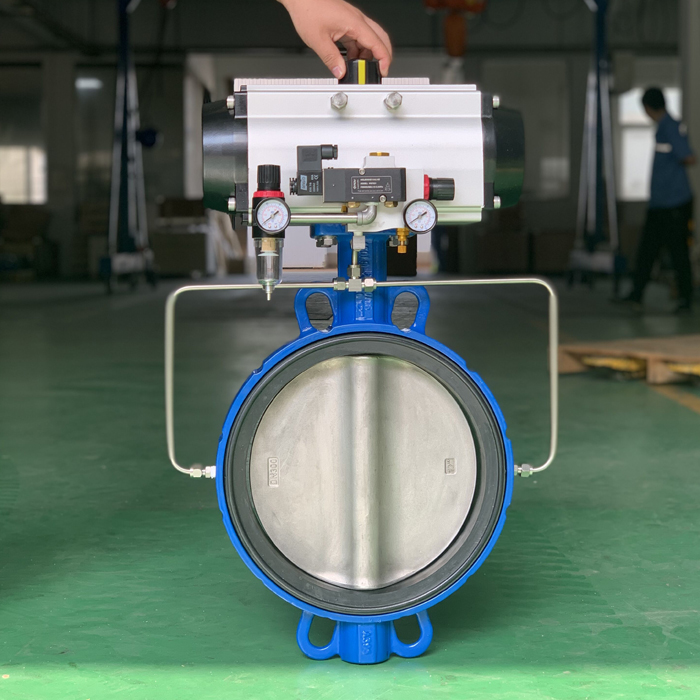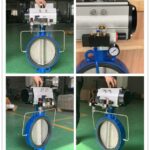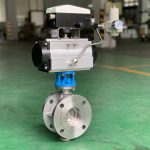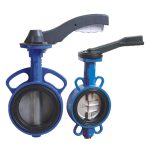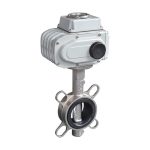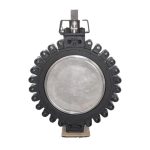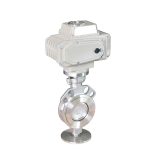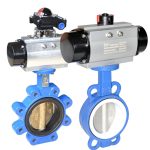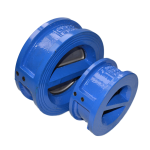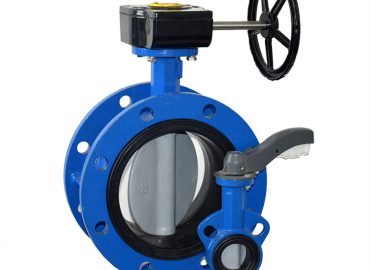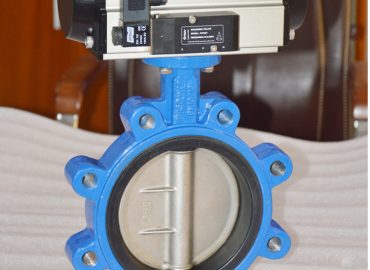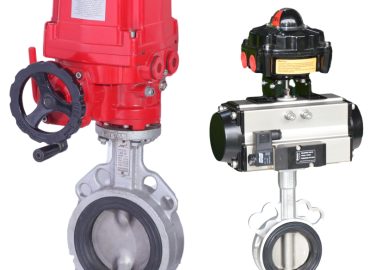Welcome to our comprehensive guide on inflatable seat pneumatic butterfly valves. These unique and versatile pieces of equipment play a crucial role in numerous industries, helping control the flow of various types of fluids. Whether you’re an engineer looking to understand the design complexities, a buyer eager to make an informed choice, or someone simply wanting to learn how these valves contribute to different applications, this guide is for you. We’ll delve into the intricacies of their design, explore their wide-ranging applications, and shed light on why they are preferred in certain situations. So, let’s embark on this journey to unravel the world of inflatable seat pneumatic butterfly valves!
Introduction
The inflatable seat pneumatic butterfly valve is a unique piece of engineering marvel, designed to regulate and control the flow of various types of fluids in a pipeline system. These valves are innovative solutions that combine the principles of fluid mechanics, material science, and precision engineering to achieve optimal performance. The design of an inflatable seat pneumatic butterfly valve involves a disc or a plate, the ‘butterfly’, which rotates on an axis perpendicular to the direction of flow in the pipe. The inflatable seat, the distinguishing feature of this type of valve, allows for a tighter seal when the valve is closed, preventing any leakage. Pneumatics, the use of compressed gas, usually air, provides the force that moves the butterfly disc to open or close the valve. This design offers several advantages such as easy installation, a compact size that requires less space, and lower maintenance costs. Applications of inflatable seat pneumatic butterfly valves are vast, ranging from water treatment plants, oil and gas industries, chemical processing plants, to HVAC systems. Each application demands specific materials and designs based on the nature of the fluid, pressure conditions, and temperature variations. Hence, a comprehensive understanding of its design and applications is crucial for its effective utilization in various industrial contexts.
Brief overview
In this blog post, we aim to provide a comprehensive guide on inflatable seat pneumatic butterfly valves. We will cover a wide array of topics including an in-depth understanding of what these valves are and the principles behind their operation. We will dissect their design, exploring each component and its function in the overall system. The discussion will then shift to the diverse applications of these valves across various industries, highlighting their versatility and importance. We will also discuss the advantages they offer over other types of valves, thereby providing insights into why they are a preferred choice in certain scenarios. The latter part of the blog will serve as a buying guide, offering tips and factors to consider when purchasing these valves. Lastly, we will share some maintenance and troubleshooting tips to ensure the longevity and optimal performance of these valves. Whether you are a seasoned professional or a curious learner, this blog post promises to enhance your understanding of inflatable seat pneumatic butterfly valves.
Importance of understanding inflatable seat pneumatic butterfly valve
Understanding the mechanics and functionalities of an inflatable seat pneumatic butterfly valve is vital for various reasons. For professionals in industries such as water treatment, oil and gas, chemical processing, or HVAC systems, a thorough knowledge of these valves can significantly impact the efficiency and safety of their operations. By fully comprehending how these valves function, individuals can make informed decisions about their installation, maintenance, and troubleshooting, ultimately enhancing the lifespan and performance of their overall system. Moreover, this understanding is crucial when it comes to purchasing decisions. Different applications require different types of valves, and understanding the specific advantages and functionalities of an inflatable seat pneumatic butterfly valve can guide buyers to select the most suitable option for their needs. Hence, whether you’re a professional in the field, a student of engineering, or a buyer in the industry, understanding these valves can be greatly beneficial.
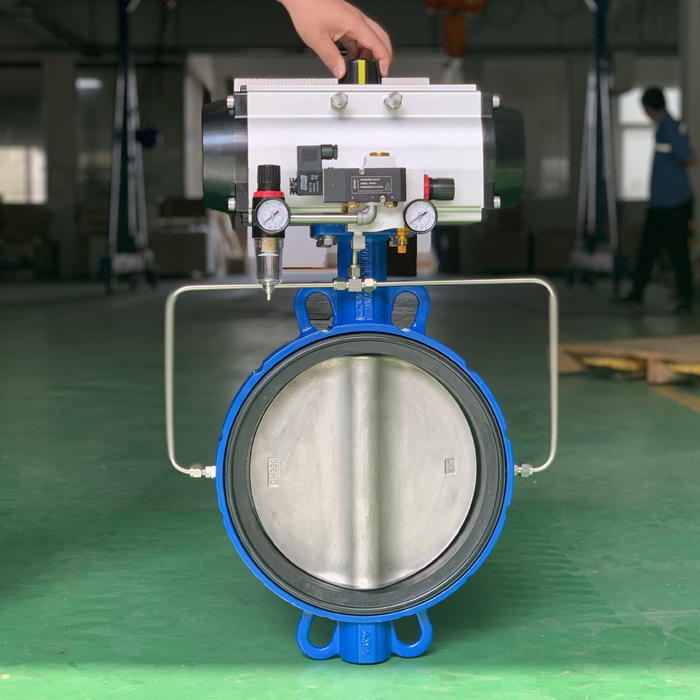
What is an Inflatable Seat Pneumatic Butterfly Valve?
An inflatable seat pneumatic butterfly valve is a type of flow control device that is used to regulate the flow of a fluid in a pipeline. The valve operates by using a disc or a ‘butterfly’ that rotates around an axis, which is usually at a 90-degree angle to the direction of flow. The name ‘inflatable seat’ comes from a unique feature of this valve – a flexible, inflatable seal or ‘seat’ that provides a tight closure when the valve is in the closed position. This eliminates any potential leakage, ensuring a secure shut-off. The term ‘pneumatic’ in its name refers to the method of actuation used to operate the valve. Instead of manual operation or electric power, this type of valve uses pressurized air or gas to move the butterfly disc and adjust the flow rate. The combination of these features results in a valve that is highly efficient, reliable, and suitable for a wide range of applications, including those involving corrosive or abrasive fluids. With its compact design, ease of installation, and lower maintenance requirements, the inflatable seat pneumatic butterfly valve is a valuable asset in various industrial settings.
Detailed explanation of what inflatable seat pneumatic butterfly valve is
An inflatable seat pneumatic butterfly valve is a specialized type of valve used to control the flow of fluids. This valve operates through a unique design that utilizes air pressure to expand the seat against the disc, providing an even pressure distribution for a bubble-tight seal, resulting in minimal friction and wear. This design allows the valve to operate with less torque, requiring a smaller actuator, thus enhancing its efficiency. The inflatable seat automatically compensates for wear, extending the valve’s life and allowing the disc to reach a 90-degree position. As the valve rotates into the closed position, the disc makes casual contact with the seat. The seat then inflates, pressing it against the disc, which ensures a tight seal. This design results in a smooth disc profile and optimal sealing capabilities, making it ideal for various industrial applications, from power generation to chemical processing.
The basic functionality and design of this type of valve
The inflatable seat pneumatic butterfly valve is ingeniously designed to manage and control the flow of fluids in a pipeline. At its core, this valve contains a disc or plate – the ‘butterfly’ – that rotates around an axis perpendicular to the flow direction. When the butterfly is turned such that it aligns with the flow, the valve is open, allowing fluid to pass through. Conversely, when the butterfly is turned to be parallel to the flow direction, the valve is closed, halting fluid flow. The unique feature of this valve type is the inflatable seat which, when inflated, creates an extremely tight seal against the butterfly disc when the valve is in the closed position, preventing any potential leakage. The pneumatic aspect of the valve refers to the use of compressed gas, usually air, to actuate or control the movement of the butterfly, opening or closing the valve as required. This design combines simplicity and efficiency, making these valves a popular choice for many industries.
Components of an Inflatable Seat Pneumatic Butterfly Valve
An inflatable seat pneumatic butterfly valve is comprised of several integral components that work together to regulate and control the flow of fluids. The first major component is the ‘butterfly’, a disc or plate that rotates on an axis perpendicular to the flow direction in the pipe. This disc is responsible for opening or closing the flow path, depending on its position. It’s connected to an actuator, another crucial component, which facilitates the movement of the disc. The actuator in this case is pneumatic, meaning it uses compressed air or gas to drive the motion of the butterfly disc. Another key component is the inflatable seat. This part creates a tight seal when the valve is closed, preventing any potential leakage. It inflates to provide a secure seal against the butterfly disc and deflates to allow the disc to rotate freely when opening the valve. The valve body, typically made from durable materials like stainless steel or cast iron, houses these components and connects to the pipeline. The valve stem, which connects the actuator and the disc, allows the transmission of force from the actuator to the butterfly disc. Lastly, the valve may also have manual overrides and position indicators to manually control the valve and indicate the position of the disc, respectively. Each of these components plays a vital role in the efficient operation of the valve, making understanding their functions essential for anyone working with these systems.
Discussion about the main components of the valve
A valve is comprised of several key components, each playing a critical role in its function. The body, often made of metal or plastic, is the main part of the valve and houses other components. Inside the body is the bonnet, which provides a leakproof closure for the valve body and a mounting surface for the valve’s actuating elements. The disc or gate is the movable part that opens, closes, or partially obstructs the flow path. The stem connects the actuator and disc, transmitting motion from the former to the latter. Seals or packing are used to prevent leaks along the stem. The actuator (which could be manual, electric, pneumatic, or hydraulic) operates the stem and disc assembly. Understanding these components is essential as it aids in the maintenance, troubleshooting, and effective operation of the valve.
Explanation of each component’s role in the overall functioning of the valve
The functioning of a valve involves several components, each playing its unique role. At the heart of the valve is the disc, which regulates the flow of fluid by rotating to open, close or partially obstruct the passageway. The stem, connected to the disc, facilitates this movement, often driven by an actuator – a device that converts energy (typically electric) into mechanical motion. The seat of the valve, often made of durable material, forms a seal with the disc to prevent leakage when the valve is closed. In an inflatable seat pneumatic butterfly valve, the seat is inflatable, providing a tighter seal and less wear and tear. The body of the valve houses these components and connects to the piping system. Lastly, the handwheel or lever allows manual control of the valve. Together, these components ensure the smooth and efficient operation of the valve, controlling the flow of fluids within a system.
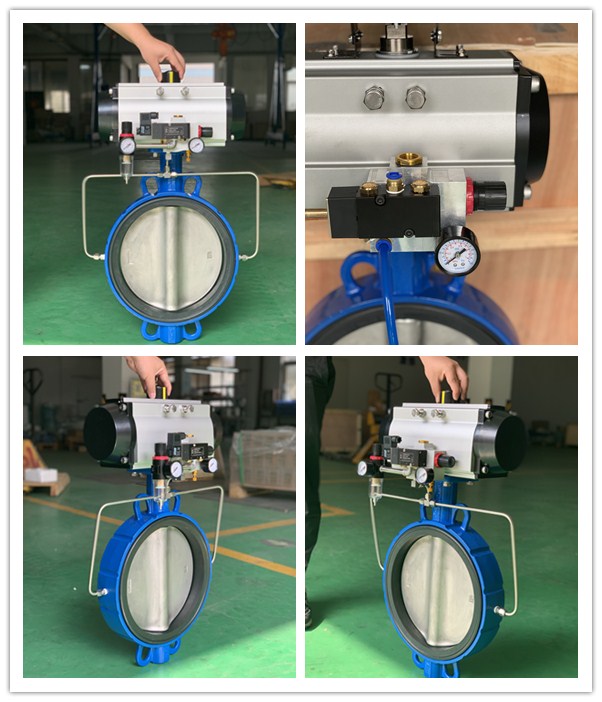
Design of an Inflatable Seat Pneumatic Butterfly Valve
An inflatable seat pneumatic butterfly valve is an ingenious piece of engineering, designed with several unique features that contribute to its efficient operation. Its most notable element is the inflatable seat. This innovative design feature allows for a tight seal when the valve is in its closed position, reducing leakages and enhancing the overall efficiency of the system. The seat inflates to create a complete seal and deflates to allow the disc to move freely, thus enabling control of fluid flow.
The valve operates using a pneumatic actuator, a component that uses air pressure to create motion. The actuator is connected to the valve’s disc via a stem. When the actuator is activated, it moves the stem, which in turn rotates the disc. This rotation opens or closes the valve, regulating fluid flow within the system.
The body of the valve, typically made from durable materials like stainless steel, houses these components and provides a path for the fluid. It is designed to withstand various operational pressures and temperatures, making the valve versatile for different industrial applications.
The valve’s disc is another crucial component. It is usually designed in a butterfly shape, hence the name “butterfly valve”. The disc pivots within the valve body, controlling the opening and closing of the valve.
Finally, the seals or packings play a vital role in preventing leaks. They ensure that the fluid remains within the designated flow path and does not escape through the stem or between the disc and valve body.
Overall, the combined design elements of an inflatable seat pneumatic butterfly valve allow for precise control of fluid flow, reduction of leakages, durability under varying conditions, and efficient operation, making it an invaluable tool in industries like water treatment, chemical processing, and food and beverage production.
Detailed discussion on the design aspects of this valve
The design aspects of the inflatable seat pneumatic butterfly valve are centered around efficiency, longevity, and reliability. The body of the valve, typically made of durable materials like stainless steel or cast iron, is designed to withstand high pressures and temperatures. The disc, usually made of the same material as the body or a compatible one, is carefully shaped to allow for optimal fluid flow when open and a secure seal when closed. One of the distinguishing design features of this valve is the inflatable seat. This unique feature allows for a tighter seal when the valve is in the closed position, thus minimizing leakage. The pneumatic actuator is another crucial component, using air pressure to control the movement of the disc. It’s designed for quick response times and reliable operation. Lastly, seals and gaskets are incorporated into the design to prevent any potential leaks. Overall, each element of the valve’s design contributes to its robust performance in various industrial applications.
How the design contributes to the valve’s efficiency and effectiveness
The design of a valve significantly contributes to its efficiency and effectiveness. For instance, in an inflatable seat pneumatic butterfly valve, the inflatable seat design allows for a more secure seal when the valve is closed, thereby reducing leakage and enhancing operational efficiency. This design is particularly effective in handling both low and high-pressure operations, making the valve versatile for various industrial applications. The body of the valve, typically made from durable materials like metal or plastic, ensures longevity and resistance against harsh conditions. The disc’s design, which opens, closes, or partially obstructs the flow path, directly impacts the valve’s ability to regulate fluid flow effectively. Additionally, the actuator’s design, whether manual, electric, pneumatic, or hydraulic, influences the ease and reliability of valve operation. Thus, every aspect of a valve’s design plays a crucial role in its overall efficiency and effectiveness.
Applications of Inflatable Seat Pneumatic Butterfly Valves
Inflatable seat pneumatic butterfly valves have a wide range of applications across various industries due to their unique design and efficient functionality. In the water treatment industry, these valves serve a critical role in controlling the flow and pressure of water through the system. Their ability to provide a tight seal when closed makes them ideal for preventing leaks and ensuring the efficient operation of treatment plants. In the chemical processing sector, the durable construction of these valves allows them to withstand corrosive substances and high temperatures, making them a reliable choice for controlling the flow of different chemicals. The food and beverage industry also benefits from these valves’ sanitary design, which helps maintain cleanliness during processing and prevent cross-contamination. Furthermore, these valves are often used in power plants, pulp and paper mills, HVAC systems, and oil and gas pipelines. Their versatility and high performance make them an integral component in many industrial processes. The inflatable seat feature, in particular, provides enhanced sealing capabilities under varying pressure conditions, enhancing their suitability for both high-pressure and low-pressure applications. By understanding the specific benefits and applications of inflatable seat pneumatic butterfly valves, businesses can make informed decisions about their use in various operational contexts.
Various industries where these valves are used
Inflatable seat pneumatic butterfly valves are used in a wide range of industries due to their efficiency, versatility, and robustness. They are commonly used in the water treatment industry, where they regulate flow and pressure within filtration systems and pipelines. In the oil and gas industry, these valves are employed for their ability to withstand high pressures and temperatures, ensuring safe and efficient operation. In the chemical processing industry, they are preferred for their leak-proof design and resistance to corrosive substances. The food and beverage industry also extensively uses these valves due to their sanitary design and ease of cleaning which prevents contamination. Moreover, in the power generation sector, they are utilized in cooling systems, boilers, and other equipment for effective flow control. Therefore, the design and functionality of inflatable seat pneumatic butterfly valves make them a valuable tool in various industrial applications.
Specific applications within these industries
Inflatable seat pneumatic butterfly valves have diverse applications within various industries. In the water treatment industry, they are often used to control the flow of water in filtration systems, ensuring only treated water passes through. In chemical processing plants, these valves regulate the flow of corrosive substances during the manufacturing process, preventing potential damage to equipment and ensuring safety standards are met. In the food and beverage industry, they are utilized in sterilization processes, where their ability to withstand high temperatures and create a tight seal is crucial. These valves are also used in bottling or canning lines to control the flow of liquids into containers. In power plants, they are employed in cooling systems to regulate the water flow used for cooling purposes. In pulp and paper mills, these valves control the flow of raw materials and chemicals during the pulping process. Similarly, in HVAC systems, they are essential in regulating airflow, contributing to efficient heating or cooling. Lastly, in the oil and gas industry, these valves are used in pipeline systems for controlling the flow and pressure of oil and gas, contributing to safe and efficient operations.
Real-world examples of these applications
Inflatable seat pneumatic butterfly valves and PVDF diaphragm valves are both integral in real-world applications across various industries. For example, in the city of New York’s waste water treatment plants, inflatable seat pneumatic butterfly valves are used to control the flow of water and waste materials through the system. Their ability to provide a tight seal when closed helps prevent leaks and ensures the efficient operation of the plant. On the other hand, PVDF diaphragm valves are extensively used in the pharmaceutical industry, such as Pfizer’s manufacturing units. These valves’ anti-corrosive properties make them ideal for controlling the flow of harsh chemicals used in drug production. Furthermore, in oil refineries like ExxonMobil, these valves are used in the pipeline systems to regulate the flow of oil and gas, thanks to their high durability and resistance to corrosive substances. These real-world examples underscore the importance of these valves in maintaining industrial operations’ efficiency and safety.
Advantages of Using Inflatable Seat Pneumatic Butterfly Valves
Inflatable seat pneumatic butterfly valves offer several advantages that make them an ideal choice for various industrial applications. One of the key benefits is their ability to provide airtight sealing. The inflatable seat, when inflated, forms a tight seal around the disc of the valve, preventing any potential leaks and ensuring a secure shut-off. This feature is particularly beneficial in industries where leak prevention is critical, such as in chemical processing or water treatment facilities. Another advantage is their robust and durable construction. These valves are typically made from high-quality materials that can withstand harsh conditions, including exposure to corrosive substances and high temperatures. This makes them suitable for use in a wide range of environments, from oil and gas pipelines to power plants. Additionally, inflatable seat pneumatic butterfly valves often come with a manual override option, providing an added layer of safety in case of pneumatic system failure. They also offer ease of maintenance. The inflatable seat can be easily replaced if it gets worn out, reducing downtime and increasing the overall lifespan of the valve. Lastly, these valves are highly versatile and can be used in both high-pressure and low-pressure applications, making them a cost-effective solution for various flow control needs.
Discussion on why these valves are preferred in certain situations
Air-operated diaphragm valves are often preferred in certain situations due to their unique design and operational advantages. They are self-priming, can run dry without damage, and have the ability to handle sludges, slurries, and other viscous fluids with ease, making them ideal for applications where these conditions exist. Their seal-less design eliminates leaks, reducing the risk of contamination or environmental harm, which is especially critical in industries such as chemical processing or wastewater treatment. Additionally, these valves are capable of deadheading (running against a closed discharge) without any harm, providing superior flexibility in various system configurations. Lastly, their simplicity and ease of maintenance make them desirable in situations where quick servicing is needed to minimize downtime. Therefore, air-operated diaphragm valves’ unique features and capabilities make them a go-to option in numerous challenging scenarios.
Benefits of using these valves compared to other types of valves
Inflatable seat pneumatic butterfly valves and PVDF diaphragm valves offer several advantages over other types of valves. One of the key benefits is their ability to provide a tight seal, reducing the risk of leaks and ensuring more efficient operation. This is particularly essential in industries dealing with hazardous or corrosive materials. Additionally, these valves are known for their durability and resistance to high temperatures and pressures, making them suitable for heavy-duty industrial applications. They also offer greater flow control precision, which is crucial in processes that require accurate flow regulation. Compared to other valves, they are easier to install and maintain, leading to reduced downtime and lower maintenance costs. Furthermore, their sanitary design makes them an ideal choice for industries like food and beverage and pharmaceuticals, where hygiene and cleanliness are paramount. Lastly, their versatility allows them to be used in a wide range of applications, providing a cost-effective solution for various industries.
Buying Guide for Inflatable Seat Pneumatic Butterfly Valves
When purchasing inflatable seat pneumatic butterfly valves, there are several factors to consider to ensure you select the right product for your specific needs. First and foremost, it’s crucial to understand the nature of your application. This includes knowing the type of fluid or gas the valve will control, its temperature, pressure, and corrosiveness. These factors will help determine the appropriate material for the valve. For instance, stainless steel might be suitable for high-temperature applications, while PVC or other plastic materials may be better for corrosive environments. Next, consider the size of the valve. The valve’s size should correspond with the size of the pipe it will be installed in. Inflatable seat pneumatic butterfly valves come in various sizes, so it’s essential to choose one that fits your system perfectly. Another important factor is the valve’s actuation method. Pneumatic actuation is generally faster and more reliable than manual actuation, but it requires a source of compressed air. If this isn’t available, a manual or electrically actuated valve might be more suitable. It’s also worth considering the valve’s maintenance requirements. Look for a valve with easy-to-replace components, as this can reduce downtime and maintenance costs. Lastly, always buy from a reputable manufacturer or supplier. They should provide comprehensive technical support, warranties, and after-sales services. By taking all these factors into account, you can ensure that you choose the most suitable inflatable seat pneumatic butterfly valve for your application.
Factors to consider when purchasing this type of valve
When purchasing inflatable seat pneumatic butterfly valves, there are several key factors to consider. The first is the nature of your application. This includes understanding the type of fluid or gas the valve will control, its temperature, pressure, and corrosiveness. These considerations will influence the ideal material for your valve. Secondly, consider the size of the valve. The valve’s size should correspond with the size of the pipe it will be installed in. Thirdly, pay attention to the actuation mechanism. Pneumatic actuation is often faster and more reliable than manual actuation, but it requires a source of compressed air. If this isn’t available, you might want to opt for a manually or electrically actuated valve. Fourthly, think about maintenance requirements. A valve with easy-to-replace components can reduce downtime and maintenance costs. Lastly, always purchase from a reputable supplier or manufacturer who can provide technical support, warranties, and after-sales service. By taking these factors into account, you can ensure you select the most appropriate valve for your needs.
Tips on selecting the right valve for specific applications
Choosing the right valve for a specific application can significantly impact the efficiency and effectiveness of your overall system. The first tip to consider is understanding your application requirements. This includes the type of fluid or gas to be controlled, the operating pressure and temperature, and the required flow rate. These factors will guide you towards the right type of valve, whether it’s a gate, globe, check, butterfly, diaphragm, or ball valve. Secondly, the material of the valve is crucial. It should be compatible with the fluid or gas to avoid corrosion over time. For instance, stainless steel valves are excellent for high-temperature applications, while brass or bronze valves work well in less corrosive environments. Thirdly, the size of the valve must match the size of the pipe it will be installed in to ensure proper flow control. Fourthly, consider the valve operation — whether it needs to be manually operated or automated. Automated valves are ideal for applications where remote control is necessary or if the valve is located in a hard-to-reach area. Finally, maintenance and durability should also be considered. Valves that are robust, reliable, and easy to maintain will reduce downtime and save costs in the long run. Always remember, working with a reputable supplier can help you make the best decision based on your specific application needs.

Maintenance and Troubleshooting Tips
Proper maintenance and troubleshooting of any machinery or equipment are crucial to ensure its longevity and optimal performance. This is particularly true for complex systems such as valves, where small issues can quickly escalate if not addressed promptly. When it comes to maintenance, regular inspections are key. Look for signs of wear and tear, such as leaks or abnormal sounds, which could indicate a problem. Also, examine the valve’s components for any damage or corrosion. Regular cleaning is also important to prevent buildup of debris that can hinder the valve’s operation. Lubrication should be done periodically to reduce friction and prevent wear. As for troubleshooting, start by identifying the symptoms of the problem. Is the valve leaking? Is it failing to open or close properly? Once you’ve identified the issue, consult the manufacturer’s manual or seek professional advice to understand the potential causes. Common problems could be a worn-out seal, a faulty actuator, or blockages in the valve. Remember, safety should always be your top priority when performing maintenance and troubleshooting tasks. Always use the right tools and protective gear, and never attempt to repair a valve while the system is pressurized. If you’re unsure about anything, don’t hesitate to contact a professional for help.
Basic maintenance guidelines for these valves
Maintaining your inflatable seat pneumatic butterfly valves is crucial for their optimal performance and extended lifespan. Start with regular inspections, checking for any signs of wear or damage to the valve body, disc, and particularly the inflatable seat which is a critical component of these valves. Look out for any leaks, as these can indicate a problem with the seat inflation or the sealing mechanism. Regularly test the operation of the valve, ensuring it opens and closes smoothly. The pneumatic actuator should also be checked for efficient operation. Additionally, cleaning should be performed according to the manufacturer’s guidelines. Certain applications may require more frequent cleaning, especially in industries like food processing or pharmaceuticals. Lubrication is another essential maintenance task, helping to reduce friction and prevent wear. Always use the recommended lubricant and avoid over-lubrication. Lastly, always keep a record of all maintenance activities. This can help identify recurring issues and possible solutions. Remember, if you encounter any serious issues, it’s best to consult with the valve manufacturer or a trained technician.
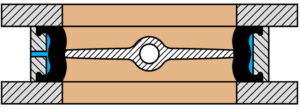
Common issues and how to troubleshoot them
While inflatable seat pneumatic butterfly valves are known for their durability and reliability, they can occasionally encounter issues that may affect their performance. One common problem is leakage, which often results from a damaged or worn-out inflatable seat. Regular inspection and timely replacement of the seat can prevent this issue. Another common issue is the valve not opening or closing properly. This could be due to a problem with the pneumatic actuator, such as insufficient air supply or a malfunctioning solenoid valve. Checking the air supply and inspecting the solenoid valve can help troubleshoot this problem. If the valve is not sealing properly, it might be due to debris or foreign objects lodged in between the disc and the seat. Cleaning the valve regularly and ensuring the pipeline is free from debris can resolve this issue. In cases where these troubleshooting steps do not resolve the problem, it is recommended to consult with a professional or contact the manufacturer’s technical support for further assistance. Remember, regular maintenance and timely repairs are key to prolonging the lifespan of your valve and ensuring optimal performance.
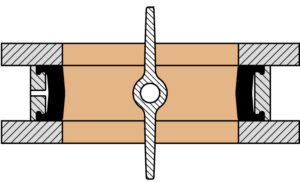
Conclusion
In conclusion, the inflatable butterfly valve is a versatile and effective solution for various industrial applications. Its unique design, characterized by an inflatable seat, ensures a tight seal preventing any leakage. This makes it particularly useful in industries where fluid control is of utmost importance.
The pneumatic actuation of this valve type further adds to its efficiency, providing fast and accurate control. It also reduces the need for manual intervention, making it an ideal choice for remote or hard-to-reach applications. In addition, the use of an inflatable seat enhances the durability of the valve, minimizing wear and tear even in high-pressure environments.
However, as with any mechanical device, understanding its operation and maintenance is crucial. Regular inspection and timely replacement of worn-out components can significantly extend the valve’s lifespan and ensure its optimal performance. It’s also important to choose the right material for the valve depending on the nature of the fluid it will handle to avoid corrosion and other potential damage.
In terms of applications, the inflatable seat pneumatic butterfly valve finds its use in a wide array of industries ranging from water treatment, chemical processing, oil and gas, to food and beverage. Its ability to handle both liquid and gas mediums, coupled with its robust design, makes it a reliable choice for these sectors.
This comprehensive guide aimed to shed light on the design and application aspects of the inflatable seat pneumatic butterfly valve. Whether you are an engineer, a technician, or someone interested in fluid control systems, we hope this information helps you understand this valve type better. Remember, choosing the right valve can make a significant difference to the efficiency and safety of your operations. So always consider your specific needs and seek expert advice when necessary.
Recap of the main points discussed in the blog post
In this blog post, we delved into the significant role of inflatable seat pneumatic butterfly valves in mining applications. We highlighted their efficiency in handling abrasive and corrosive environments, their critical role in slurry control, and the benefits of their flange connection design. We also discussed the importance of regular maintenance including inspections for wear or damage, testing of operational efficiency, and proper cleaning and lubrication practices. Additionally, we touched on common issues that may arise, such as leakage and improper opening or closing, offering troubleshooting tips for each. Finally, we emphasized the importance of consulting professionals or manufacturer’s technical support in case of serious issues. Overall, the post underscored the value of these valves in enhancing productivity and safety in mining operations, while ensuring their longevity through proper care and handling.
Final thoughts on the importance and utility of inflatable seat pneumatic butterfly valves
In conclusion, the inflatable seat pneumatic butterfly valve stands out as an essential tool in fluid control applications across various industries. Its unique design, featuring an inflatable seat, ensures airtight sealing and prevents leakage, a crucial requirement in many industrial processes. The pneumatic actuation facilitates fast, accurate, and automated control, reducing the need for manual intervention. Moreover, their robust construction and durability make them an economical choice in the long run. By understanding their operation and ensuring regular maintenance, these valves can significantly enhance the efficiency and safety of your operations. In essence, the importance and utility of inflatable seat pneumatic butterfly valves cannot be overstated. They truly are a testament to the advancements in valve technology, meeting the ever-evolving needs of industrial applications.


